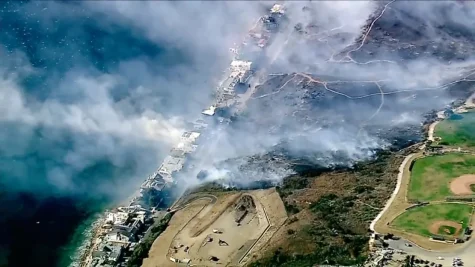
Sophia Yeskulsky | Head Editor
November 7, 2024
A rapidly spreading mountain fire broke out in Southern California’s Ventura County, forcing thousands of residents to evacuate and injuring several people. The fire erupted on Wednesday (11/6) morning, driven by intense Santa Ana winds that whipped flames across neighborhoods between Moorpark and Somis. These high winds, which reached gusts of up to 64 mph, grounded firefighting aircraft and challenged the 800 firefighters on the scene. According to Ventura County Fire Captain Trevor Johnson, the flames moved so swiftly that firefighters had to evacuate residents in fire engines, as visibility dropped to near zero in some areas due to smoke and dust.

The blaze had consumed over 14,000 acres by Wednesday afternoon, with zero containment. Authorities closed parts of State Route 118 as flames leaped across the freeway, and smoke slowed traffic on the nearby U.S. 101. Many schools closed, and power outages affected over 23,000 residents due to the risk posed by downed power lines. Meanwhile, a secondary blaze, the Broad Fire in Malibu, forced more evacuations, affecting homes and spreading to over 33 acres.
The frequency and intensity of wildfires like the Mountain Fire are part of a disturbing trend in California, where fires have been increasing in recent years due to a combination of climate change, urban development, and specific weather conditions. According to Dr. John Fisher, a climate scientist from Chapman University, factors such as topography, dry vegetation, and Santa Ana winds contribute to the rapid spread of fires, making Southern California especially vulnerable. Santa Ana winds are seasonal, hot, dry gusts that blow from the desert toward the coast, creating perfect conditions for wildfires when combined with the state’s parched vegetation. This year, California endured its hottest summer on record, exacerbating the state’s already dry conditions and providing ample fuel for fires. Senior Taylor Hernandez explained how this year, she noticed that “there has been an increase in days with poor air quality due to California wildfires.”
Climate change has made California’s fire seasons longer and more intense, transforming wildfires from seasonal phenomena into year-round threats. Rising global temperatures contribute to drier summers and prolonged droughts, which reduce the moisture content in plants, making them highly flammable. Recent wet winters, attributed to climate change as well, have led to abundant plant growth, which then dries out in the summer, increasing the amount of burnable material. As more people move into California’s wildland-urban interface areas, the likelihood of fires ignited by human activities, such as a stray spark or faulty equipment, also rises. Senior Kiana Breshears commented, “It’s important that Californians are aware of this increasing trend and continue to combat climate change.”
Data from Cal Fire shows that the state has experienced about a 290% increase in acres burned this year than last year, underscoring the growing impact of wildfires. With climate change continuing to alter weather patterns and intensify drought conditions, the risk of devastating wildfires in California remains high.

Leave a Reply